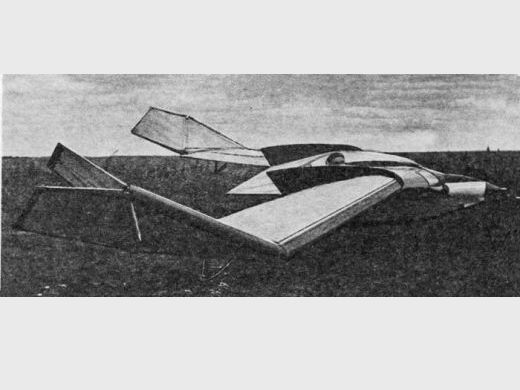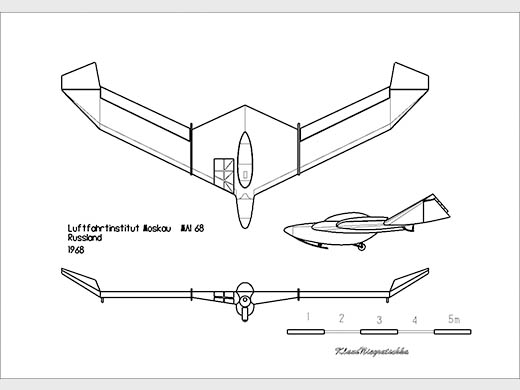
MAI-68 Pushinka
Autre nom (ou nom en langue originelle) : МАИ-68 Пушинка| DONNÉES GÉNÉRALES |
| Année du premier vol (ou de design, si seul projet) |
1970 |
| Pays | URSS |
| Designer(s) | PUSHKIN, Vladimir |
| Premier constructeur | UPM MAI (Uchebno-Proizvodstvennie Masterskie MAI) |
| Type d'appareil | Aile volante |
| Fonction | Expérimental |
| SPÉCIFICATIONS TECHNIQUES |
| Envergure | 10 m |
| Longueur | 5 m |
| Hauteur | -- |
| Allongement | 8.54 |
| Surface alaire | -- |
| Profil aile | R-S-15.5 |
| Masse à vide | 86 kg |
| Masse maxi | 170 kg |
| Charge alaire | -- |
| Vitesse mini | 45 km/h |
| Vitesse maxi | -- |
| Finesse maxi | 21 |
| Taux de chute mini | -- |
| Nb sièges | 1 |
| Structure | -- |
AUTRES INFORMATIONS
| Constructeur(s) |
| ||||||
| Infos techniques | |||||||
| Histoire résumée | Further development of the "flying-wing" concept proposed by A. I. Pietsukh resulted in the "tailless" glider MAI-68. This glider completes the series of MAI experimental aircraft, the first of which was the "flying-wing" motorplane MAI-62. On the basis of previous studies to determine the appearance of a new aerodynamic configuration, student V. Pushkin started to design in 1966 a "flying-wing" glider. The glider was named "Pushinka" (Fluff) and got the designation MAI-68. The glider was designed in accordance with the requirements and technical specifications for single-seat training gliders and to create the initial arrangement a study was done by comparing schemes to classical arrangment. The integrated scheme in which the fuselage, wing and tail combined into a single meaningful unit was selected. The experimental glider was built by Vladimir Pushkin in 1968 - 1970. In July 1970, the ground and flight testing was started on the ASK MAI airfield (ASK: Aviatsionno-Sporttivniy Klub - Aviation Sport Club). Tests were carried out of by the head of the club, I. G. Yermakov. For ground runs a winch of "Hercules III" type was used. During ground runs rudder control effectiveness, the glider's stability and control were tested. Taxiing speed was gradually increased. At the first trials a noticeable lag in rudder control were experienced. Therefore, the area ahead of the rear halves of the rudder was increased, which allowed to get sufficient lateral control to fly the glider and to make 30-45 degrees roll turns at a height of 250-300 meters. Take-offs were done by aerotow using a Yak-12 aircraft. In flight, the glider has shown stability. Tests were conducted up to 1972. 12 launches approaching the height of 1-2 m, 26 flights at a height of 40-70 m and four flights on 250-300 m were done. Further flight tests continued in the TsAGI (1973-1974). Glider test pilot V. Vladimirov made the test flights. As a result of flight tests of the experimental glider "Pushinka" the reliability and effectiveness of the new integrated solution had been proved. | ||||||
| Liens personnalités | Pas de personnalité associée. |
SOURCES DOCUMENTAIRES
| Liens WEB | Site : Site Coin de Ciel (Уголок неба) . Texte + photo + plan 3 vues + specs. (2009-11-01 CL) Site : 100 Jahre Nuflügel /A century of flying wings de Klaus Niegratschka . une photo [Lien mort]. (2020-05-04 CL) Site : Nuricom (Klaus Niegratschka) . Plan 3 vues [Lien mort]. (2020-05-04 CL) Site : EcuRed . Texte + photo + plan 3 vues + specs (en espagnol). (2020-05-04 CL) Site : AviaMuseum (Проект Авиару.рф) . Texte + 8 photos + plan 3 vues. (2020-05-04 CL) |
| Livres | Entsiklopediia Planery Rossii par KRASILSHCHIKOV, A. P. (2005) [p. 188, 251, 331. Note + photo + specs]. |

Team J2mcL © 2003 -
- Pages optimisées pour Mozilla Firefox

